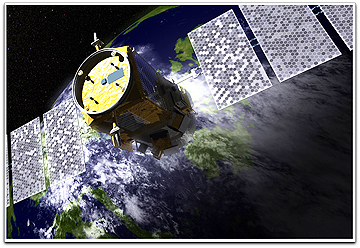CALIPSO provides a unique vertical profile measurement of clouds and aerosols using space-borne Light Detection and Ranging (lidar). Integrated with other measurements from a constellation of five satellites, one from France and four from NASA, called the A-Train, CALIPSO's observations are improving our understanding of two poorly understood variables in Earth's changing climate: aerosols and clouds and their interactions. CALIPSO's near-simultaneous measurements with the other instruments can be integrated with and also enhance data gathered by satellites such as CloudSat. "This mission continues to be a success," said Chip Trepte, CALIPSO's project scientist, based at NASA's Langley Research Center. "We completed the objectives of the prime mission, which were to determine the location and frequency of clouds and aerosol layers over the globe and some of their properties, through at least three years. CALIPSO is filling a measurement gap that other satellite missions are unable to provide."
Satnews Daily
April 17th, 2009
CALIPSO's Backup Lasers On
The Cloud-Aerosol Lidar and Infrared Pathfinder Satellite Observations (CALIPSO) satellite has resumed operations after switching from its primary to its backup laser nearly three years after the launch of a satellite that is helping scientists solve the puzzle of how clouds and aerosols affect Earth's climate.
 The backup laser was designed into CALIPSO to make it robust, in case the primary laser became unreliable. The value of the planning came to the forefront earlier this year as the primary laser began to behave erratically, due to a slow pressure leak in the laser's canister. The leak was known about since prior to launch, and likely came about during fabrication. The CALIPSO team, a joint effort between NASA and Centre National d'Etudes Spatiales (CNES), worked together to start up the backup laser, which hadn't been used in three years. It provided its "first light" aerosol and cloud vertical profiles on March 12th. The instrument then resumed normal operations and is undergoing a calibration review now. The release of standard data products should resume in late April, and once data is re-processed the total gap due to the switch will be about 10 days.
The backup laser was designed into CALIPSO to make it robust, in case the primary laser became unreliable. The value of the planning came to the forefront earlier this year as the primary laser began to behave erratically, due to a slow pressure leak in the laser's canister. The leak was known about since prior to launch, and likely came about during fabrication. The CALIPSO team, a joint effort between NASA and Centre National d'Etudes Spatiales (CNES), worked together to start up the backup laser, which hadn't been used in three years. It provided its "first light" aerosol and cloud vertical profiles on March 12th. The instrument then resumed normal operations and is undergoing a calibration review now. The release of standard data products should resume in late April, and once data is re-processed the total gap due to the switch will be about 10 days.
CALIPSO provides a unique vertical profile measurement of clouds and aerosols using space-borne Light Detection and Ranging (lidar). Integrated with other measurements from a constellation of five satellites, one from France and four from NASA, called the A-Train, CALIPSO's observations are improving our understanding of two poorly understood variables in Earth's changing climate: aerosols and clouds and their interactions. CALIPSO's near-simultaneous measurements with the other instruments can be integrated with and also enhance data gathered by satellites such as CloudSat. "This mission continues to be a success," said Chip Trepte, CALIPSO's project scientist, based at NASA's Langley Research Center. "We completed the objectives of the prime mission, which were to determine the location and frequency of clouds and aerosol layers over the globe and some of their properties, through at least three years. CALIPSO is filling a measurement gap that other satellite missions are unable to provide."
CALIPSO provides a unique vertical profile measurement of clouds and aerosols using space-borne Light Detection and Ranging (lidar). Integrated with other measurements from a constellation of five satellites, one from France and four from NASA, called the A-Train, CALIPSO's observations are improving our understanding of two poorly understood variables in Earth's changing climate: aerosols and clouds and their interactions. CALIPSO's near-simultaneous measurements with the other instruments can be integrated with and also enhance data gathered by satellites such as CloudSat. "This mission continues to be a success," said Chip Trepte, CALIPSO's project scientist, based at NASA's Langley Research Center. "We completed the objectives of the prime mission, which were to determine the location and frequency of clouds and aerosol layers over the globe and some of their properties, through at least three years. CALIPSO is filling a measurement gap that other satellite missions are unable to provide."

